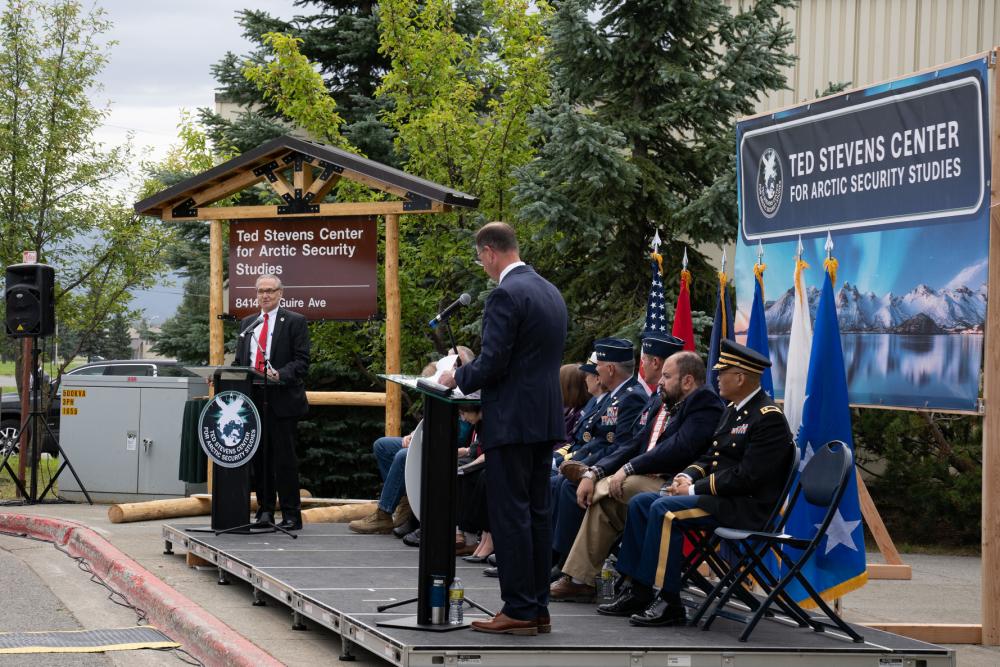How US Northern Command is growing its presence in the Arctic
Arctic security is increasingly important. A new center in Alaska is helping advocate for homeland defense capabilities.

Defending the homeland is priority number one for the North American Aerospace Defense Command (NORAD) and the United States Northern Command (USNORTHCOM). USNORTHCOM is the U.S. Department of Defense’s designated advocate for Arctic capabilities. We know too well the Arctic is not only critical to the United States but is of growing importance to strategic competitors such as China and Russia. Russia has explored northern shipping routes, and China has begun to pursue resource surveys. Both nations have also increased military rehearsals to defend their Arctic activities.
To deter malign actors in the region, ensure the defense of North America, and keep the Arctic as stable and secure as possible, we must demonstrate a consistent commitment to the region.
China and Russia are challenging internationally recognized norms that have served the world well since World War II. They attempt to alter the behaviors of U.S. allies, partners, and other Arctic-focused countries for their own benefit. Competitors who invest in military infrastructure and Arctic capabilities bring the threat closer to the U.S. homeland. Ultimately, the advanced threat capabilities that China and Russia can bring to the Arctic region reduce U.S. leaders’ decision space, erode credible deterrence options, and decrease strategic stability.
The Arctic is a top priority for Russia, highlighted by President Vladimir Putin’s recently announced naval doctrine, which cites the United States as the paramount threat and designates the Arctic Ocean as an area of particular importance for Russia. Russia is aggressively militarizing the region while proclaiming its intent to infringe upon freedom of navigation in the Northern Sea Route. Russia will likely continue enhancing its military capabilities and developing the region’s resources and infrastructure in the area. These enhancements will strengthen Russian air and coastal defense capabilities, expand its nuclear deterrent credibility, and increase its ability to place North America at risk. Russia’s geographic proximity to North America makes it a significant and growing security concern to U.S. interests in the Arctic. Russia’s irresponsible behavior in Ukraine highlights why all Arctic nations should be concerned with Russian activities and intentions in the region.
As a self-declared “near-Arctic nation,” China is attempting to establish a foothold in the northern latitudes. China has consistently increased its scientific, economic, and military activities in the Arctic over the last five years, working toward increasing influence through economic exploitation to gain access to vital natural resources. China is applying all instruments of national power to enhance its Arctic influence, expanding initiatives such as the Polar Silk Road.
The good news is the U.S. is also enhancing our commitment to the Arctic. The United States National Defense Strategy outlines the importance of “campaigning,” or aligning our activities over time to maintain our competitive advantage and support our defense priorities. A key piece of campaigning is presence — specifically having the relationships and access to operate in the region. As the Defense Department’s designated advocate for Arctic capabilities, USNORTHCOM makes its presence in the Arctic a top priority.
For USNORTHCOM, campaigning includes military exercises in the northern latitudes, to test and demonstrate capability, readiness, and our will to operate. Executing large-scale joint and multi-national force exercises under Arctic conditions exhibits credible deterrence while showcasing robust U.S. defense capabilities. Campaigning also requires close work with regional allies, partners, organizations, and institutions in the pursuit of shared objectives. We are stronger together, and our competitors know they do not benefit from the same relationships. Our integrated approach has a profound deterrent effect on competitors.
This month, we recognized a key collaboration milestone with the opening of the Ted Stevens Center for Arctic Security Studies — the Defense Department’s newest regional center. Aligned under USNORTHCOM, the Ted Stevens Center represents the Defense Department’s commitment to building strong networks of domestic and international Arctic-minded security leaders to help promote the Arctic as a peaceful and stable region, where international cooperation based on shared values is paramount. The center will advance awareness of Arctic issues, address the implications of environmental change, and emphasize the importance of maintaining a rules-based order in the region. The Ted Stevens Center will institutionalize knowledge to improve our strategic decisions regarding investments in critical Arctic capabilities and infrastructure.
The changing Arctic environment and increasing competitor activities in the region should invoke a sense of urgency in all of us. More work remains to effectively deter malign competitor activities and ensure an Arctic region governed by a rules-based international order. But our efforts to develop and demonstrate Arctic capabilities, and to establish or strengthen multilateral organizations to address Arctic concerns, are clear indicators of progress toward security for this important region.
U.S. Air Force Gen. Glen D. VanHerck, a command pilot with more than 3,200 hours in more than a dozen aircraft, is commander of NORAD and of U.S. Northern Command.
The views expressed here are the writer’s and are not necessarily endorsed by ArcticToday, which welcomes a broad range of viewpoints. To submit a piece for consideration, email commentary (at) arctictoday.com.